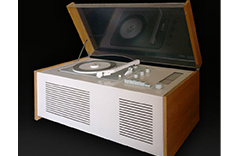Content
Dieter Rams

Dieter Rams amidst his works
Award for legendary designer Dieter Rams
Design icon Dieter Rams receives the WDO's 2025 World Design Medal
The World Design Organisation (WDO) honours designer Dieter Rams with the 2025 World Design Medal. “Few designers have left a mark as indelible as Dieter Rams“, the Jury stated. „His unwavering and long-standing commitment to design integrity have not only shaped the objects around us, but also the very values of our profession.”
Tribute to a „design icon“: At the ![]() DesignEuropa Awards 2024, the Lifetime Achievement Award goes to Dieter Rams. The EUIPO jury honours him as a „pioneer of both design and sustainability“ who „designed more than 200 iconic devices and shaped the look and functionality of consumer products for decades.”
DesignEuropa Awards 2024, the Lifetime Achievement Award goes to Dieter Rams. The EUIPO jury honours him as a „pioneer of both design and sustainability“ who „designed more than 200 iconic devices and shaped the look and functionality of consumer products for decades.”
Dieter Rams, born on 20 May 1932 in Wiesbaden, is considered one of the most successful and influential industrial designers of the 20th century - and a pioneer of sustainable thinking: "Rams champions a design ethos that takes into account our finite resources and challenges designers and the public alike to consider the long-term impact of consumer behaviour," the jury's statement reads.
Rams began studying architecture and interior design at the Werkkunstschule Wiesbaden in 1947. After graduating in 1953, he worked for the Frankfurt architecture firm Apel for two years before joining the electrical appliance manufacturer Braun.
At the time, Braun's design department worked closely with the legendarily influential but unfortunately short-lived Ulm School of Design, including Hans Gugelot and Otl Aicher. Ram's talent was quickly recognised. One of his first designs for Braun in 1956 was the SK 4 radio-record player combination (nicknamed "Snow White's Coffin"). The radically minimalist design of a white lacquered sheet metal body with a cover made of acrylic glass and light-coloured wood became a classic.
In 1961, Dieter Rams took over the management of the design department at Braun. He developed a unique product language that combined intuitive operation and outstanding aesthetics. Many products were far ahead of their time with their minimalist and functional design, which revolutionised the household appliance sector.
Under Ram's leadership, many pioneering electrical appliances were created that have long been regarded as design classics, such as the T 1000 world receiver, the LE1 electrostatic loudspeaker, the Regie and Atelier hi-fi components, pocket and desk lighters and the ET 66 pocket calculator.
Ram's second field of activity became furniture design. In his very first year at Braun, the 23-year-old sketched out a proposal for the company's new interior design. This contained the first idea for a rail-based, wall-mounted storage system. In 1958, the "606" shelving system was launched on the market - a system that has often often been copied to this day. Rams is still affiliated with the manufacturer Vitsoe; the "620" armchair programme, which has been produced since 1962, is also well-known.
From 1981 until his retirement in 1997, Dieter Rams taught as Professor of Industrial Design at the Hamburg University of Fine Arts. From 1987 to 1997, he was President of the German Design Council. Dieter Rams has had numerous exhibitions and has been honoured worldwide, for example with an honorary doctorate from the Royal College of Art in London. Several of his designs are part of the collection of the Museum of Modern Art in New York. Rams is co-author of various patent applications (e.g. ![]() DE3011843C2,
DE3011843C2, ![]() DE3026262A1,
DE3026262A1, ![]() DE3037608A1).
DE3037608A1).
Apple is one of the many companies that have been influenced by him. Steve Jobs and former chief designer Jonathan Ive are said to have highly valued Rams' work and philosophy. Conversely, Rams praised: "You can count the companies that really take design seriously on ten fingers. Apple is one of them."
Rams' design follows his own philosophy: he is in favour of an "end to the age of waste" and questions how we can survive on a planet with finite resources "if we just throw everything away". His credo to this day is "Good design is as little design as possible" or "Less, but better".
Text: Dr. Jan Björn Potthast, Pictures: Guenzel Rademacher Rams Foundation, Konrad Conrad Public domain via Wikimedia Commons, Andreas Kugel Rams Foundation, Vitsoe CC by SA 3.0 via Wikimedia Commons, DEPATISnet
Last updated: 10 December 2025





Not only protecting innovations
Social Media